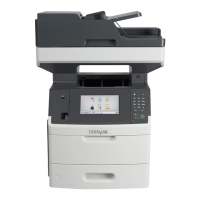Notes:
• Do not load postcards, photos, small items, transparencies,
photo paper, or thin media (such as magazine clippings) into
the ADF tray. Place these items on the scanner glass.
• The ADF indicator light comes on when the paper is loaded
properly.
2 If you are loading a document into the ADF tray, then adjust the
paper guides.
3 From the printer control panel, press # on the keypad, and then
enter the FTP shortcut number.
4 Touch > Send It.
Scanning an FTP using the address book
1 Load an original document faceup, short edge first into the ADF
tray or facedown on the scanner glass.
Notes:
• Do not load postcards, photos, small items, transparencies,
photo paper, or thin media (such as magazine clippings) into
the ADF tray. Place these items on the scanner glass.
• The ADF indicator light comes on when the paper is loaded
properly.
2 If you are loading a document into the ADF tray, then adjust the
paper guides.
3 From the home screen, navigate to:
FTP > FTP >
> type the name of the recipient > Search
4 Touch the name of the recipient.
Note: To search for additional recipients, touch New Search, and
then type the name of the next recipient.
5 Touch > Send It.
Scanning to a computer or flash drive
Scanning to a computer using the Embedded
Web Server
1 Open a Web browser, and then type the printer IP address in the
address field.
Notes:
• View the printer IP address on the printer home screen. The
IP address appears as four sets of numbers separated by
periods, such as 123.123.123.123.
• If you are using a proxy server, then temporarily disable it to
load the Web page correctly.
2 Click Scan Profile > Create.
3 Select your scan settings, and then click Next.
4 Select a location on your computer where you want to save the
scan image.
5 Type a scan name.
Note: The scan name is the name that appears in the Scan
Profile list on the display.
6 Click Submit.
Note: Clicking Submit automatically assigns a shortcut number.
You can use this shortcut number when you are ready to scan
your documents.
7 Review the instructions on the Scan Profile screen.
a Load an original document faceup, short edge first into the ADF
tray or facedown on the scanner glass.
Notes:
• Do not load postcards, photos, small items,
transparencies, photo paper, or thin media (such as
magazine clippings) into the ADF tray. Place these items
on the scanner glass.
• The ADF indicator light comes on when the paper is
loaded properly.
b If you are loading a document into the ADF tray, then adjust the
paper guides.
c Do either of the following:
• Press #, and then enter the shortcut number using the
keypad.
Note: The scanner scans and sends the document to
the directory you specified.
• From the home screen, navigate to:
Held Jobs > Profiles > locate your shortcut on the list.
8 View the file from the computer.
Note: The output file is saved in the location or launched in the
program you specified.
Setting up Scan to Computer
Notes:
• This feature is supported only in Windows Vista or later.
• Make sure that your computer and printer are connected to the
same network.
1 Open the printers folder.
In Windows 8
From the Search charm, type run, and then navigate to:
Apps list > Run > type control printers > OK
In Windows 7 or earlier
a
Click or click Start, and then click Run.
b In the Start Search or Run dialog, type control printers.
c Press Enter, or click OK.
2 Depending on your operating system, click Add devices and
printers, Add a device, or Add a printer.
3 Select your printer from the list.
Note: To identify your printer, print a network setup page, and
then look for “Fully Qualified Domain Name” in the TCP/IP
section.
4 Click Next > Close.
5 Depending on your device, do either of the following:.
• Press and hold the printer you want to configure.
• Right‑click the printer you want to configure.
6 From the menu that appears, select Scan Properties or
Properties, and then change the settings as necessary.
7 From the printer control panel, touch Scan to Computer and then
select from the following options:
• Scan—Scan and save the document directly to a selected
location on the computer.
• Scan for Print—Scan and automatically print the document.
• Scan for E‑mail—Attach a scanned document to an e‑mail.
• Scan for Fax—Attach a scanned document to be sent through
fax.
8 Touch Send It.
Remote scan in progress appears on the printer display.
The scanned image opens automatically on the computer screen.
19

